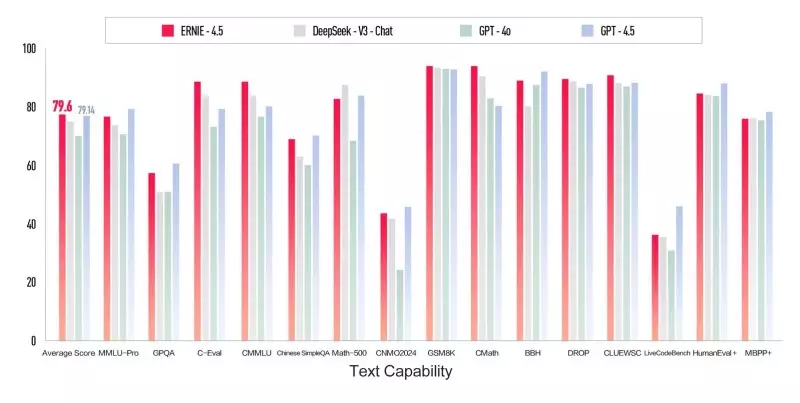Over the past weekend, Baidu, the revered Chinese tech giant, unveiled two groundbreaking AI models: ERNIE 4.5 and ERNIE X1. Both represent significant advancements in multimodal capabilities and deep reasoning, setting the stage for Baidu to emerge as a formidable competitor in the global AI landscape. The ambition behind these releases is clear: Baidu aims to deliver tools that not only outperform existing models like OpenAI’s GPT-4.5 but also do so at a fraction of the cost. This calculated approach underscores Baidu’s intent to democratize access to advanced AI technologies while establishing its position as a leader in the field.
Proven Performance Across Benchmarks
Baidu has claimed that its new models surpass those of competitors on several critical third-party benchmarks. Notably, ERNIE 4.5 and ERNIE X1 excel in assessments like the C-Eval, which evaluates knowledge and reasoning across a wide range of subjects, and the CMMLU for multitask language understanding. Such a diverse performance profile is essential, particularly for organizations looking to leverage AI in innovative and comprehensive ways.
Interestingly, the performance claims highlight a bold competitive tactic: targeting the considerable gaps left by rivals, especially on cost. For instance, ERNIE 4.5 is marketed as costing 99% less than OpenAI’s GPT-4.5. However, while competitive pricing can be enticing, potential adopters must scrutinize actual performance outcomes to ensure that these cost benefits do not come at the expense of functionality.
Cost Considerations and Limitations
While the lower cost of ERNIE models is captivating, several notable limitations deserve attention. For instance, ERNIE X1’s context window of merely 8,000 tokens is intriguingly small when compared to the expansive 128,000 tokens offered by GPT-4.5. This drastic difference raises concerns about the practical applicability of ERNIE X1 beyond customer service interfaces. Such an oversight could limit not just performance but also the scope of tasks that the model is suited for, making it an option primarily for simpler applications rather than complex problem-solving scenarios.
Moreover, the proprietary licensing model of ERNIE 4.5, contrasting with the open-source approach of competitors such as DeepSeek’s R1, may lead to hesitance among developers who prioritize transparent, customizable solutions. The decision to make ERNIE 4.5 open-source by mid-2025 indicates that Baidu recognizes this challenge but also reflects the strategic gamble they are taking in the interim.
Innovative Features and Technical Advantages
Baidu claims that both AI models are built upon an array of innovative technological enhancements, including FlashMask Dynamic Attention Masking and Heterogeneous Multimodal Mixture-of-Experts. These features lend ERNIE 4.5 its multitasking capabilities that encompass not just textual understanding but also auditory and visual data interpretation. In particular, the depth of reasoning demonstrated by ERNIE X1 could potentially revolutionize applications requiring complex analyses, setting a new standard for what reasoning in AI can accomplish.
The integration of advanced tools such as document-based question and answer systems alongside AI-generated image interpretation showcases Baidu’s vision for a multifunctional AI ecosystem. Such capabilities may resonate with industries that thrive on data-driven insights, including finance and legal sectors, emphasizing the potential for increased automation and efficiency.
Enterprise Adoption and Localized Innovations
As enterprise environments increasingly seek tailored solutions, Baidu’s commitment to localization and contextual relevance stands out. The company is poised to cater to Chinese-speaking markets with a model that understands nuanced regional directives better than broader, global AI counterparts. This localized approach could facilitate higher adoption rates in businesses concentrated in China, as ERNIE models demonstrate tailored solutions not typically offered by Western AI players.
Nevertheless, organizations must tread with caution, considering data privacy and compliance measures, especially when deploying AI tools in sensitive domains. With Baidu partial to retain industry-specific knowledge, enterprises are encouraged to remain informed on the fine print of licensing, usage policies, and the implications of cloud deployment on operational workflows.
The Future of AI with Baidu
In a rapidly evolving tech landscape for 2025, Baidu’s assertive stance introduces significant opportunities for businesses willing to embrace novel AI technologies. Through continual investment in infrastructure and data centers, the company aims to refine its foundation models further. Balancing impressive capabilities with competitive pricing, Baidu’s latest AI offerings are positioned to revolutionize the way individuals and companies approach and implement AI solutions in diverse sectors. The horizon appears promising for both innovation and accessibility, as Baidu delineates its future in the fabric of artificial intelligence.

